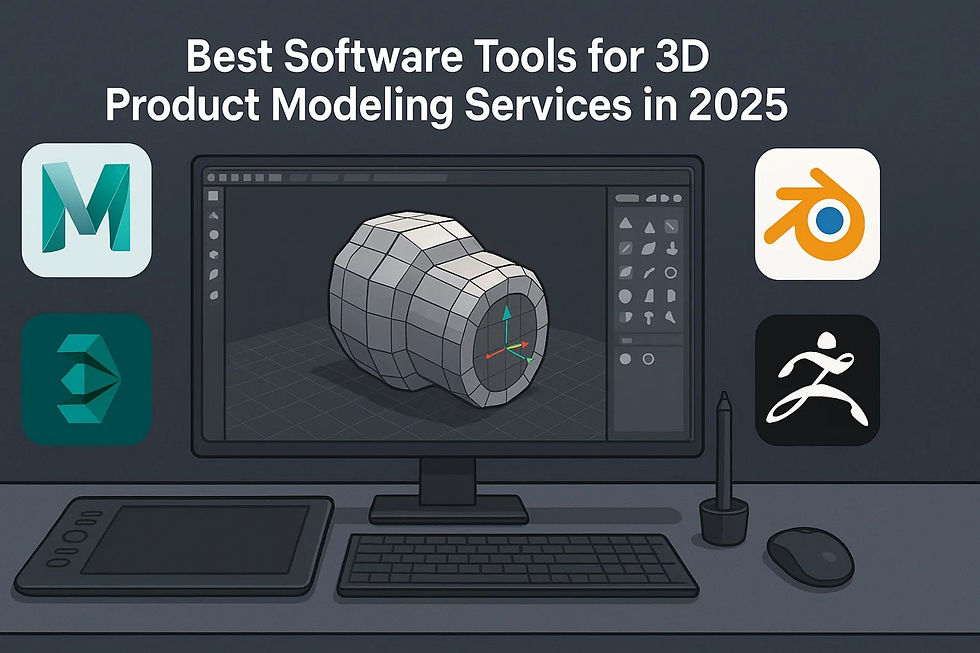How Virtual Reality 3D Modeling Is Transforming Real Estate Tours
- Hemant vizent
- Jun 17
- 4 min read

Beyond the Open House: How Virtual Reality 3D Modeling Is Transforming Real Estate Tours
The traditional real estate tour, while still a cornerstone of the home-buying process, has inherent limitations. Geographic barriers, scheduling conflicts, and the inability to visualize an unbuilt property often create hurdles for both buyers and sellers. Virtual Reality 3D Modeling is revolutionizing how properties are presented, experienced, and ultimately, sold, ushering in an era of immersive and accessible real estate tours.
No longer confined to flat photographs or even 360-degree videos, Virtual Reality 3D Modeling allows potential buyers to step inside a property and explore it as if they were physically there, regardless of their actual location.
The Limitations of Traditional Real Estate Tours
Before diving into the VR revolution, let's consider the challenges that traditional tours often present:
Geographic Barriers:
Buyers often need to travel significant distances, even across states or countries, to view properties, making the process time-consuming and expensive.
Time Constraints:
Scheduling multiple viewings can be difficult for busy individuals, and open houses offer limited personal exploration time.
Unbuilt Properties:
For new constructions or developments, buyers must rely solely on blueprints, floor plans, and artist renditions, making it difficult to truly visualize the finished space.
Lack of Context:
It's hard to understand the flow, scale, and ambiance of a property from static images.
The Immersion Revolution: What is Virtual Reality 3D Modeling?
Virtual Reality 3D Modeling is the process of creating highly detailed, interactive, three-dimensional digital representations of real estate properties, optimized for viewing within a VR headset. Unlike simple 360-degree photos that offer static panoramas, a VR 3D model allows users to:
Move Freely:
Navigate through rooms, walk down hallways, and explore every corner at their own pace.
Look Anywhere:
Turn their head to view ceilings, floors, and surrounding details just as they would in real life.
Interact with the Environment:
In more advanced VR tours, users can open doors, change material finishes, or even adjust furniture layouts.
Experience Scale and Ambiance:
Truly grasp the size of rooms, the height of ceilings, and how light flows through the space – aspects almost impossible to convey with 2D visuals.
This level of immersion is powered by precise 3D Modeling Services that build the virtual property from the ground up, ensuring every detail contributes to a believable and engaging experience.
How Virtual Reality 3D Modeling Is Transforming Real Estate Tours
The impact of Virtual Reality 3D Modeling on real estate is profound, offering benefits for developers, agents, and buyers alike:
Breaking Down Geographic Barriers:
International investors can tour a penthouse in New York from London, or a family relocating can explore homes in a new city without leaving their current one, accessible 24/7.
Visualizing Unbuilt Properties with Unprecedented Clarity:
For new developments, condominiums, or custom homes, Virtual Reality 3D Modeling is a game-changer. Developers can create a photorealistic VR 3D Modeling of a property before construction even begins. This allows prospective buyers to "walk through" their future home, see specific floor plans in 3D, choose finishes, and even see the view from their potential balcony. This ability to visualize the unbuilt significantly boosts pre-sales and reduces uncertainty.
Enhanced Buyer Engagement and Confidence:
An immersive VR tour creates a deep emotional connection. Buyers spend more time exploring a property in VR than they would with static photos, leading to a more thorough understanding and a stronger sense of ownership. This increased engagement translates directly into higher conversion rates and reduced buyer's remorse, as the 3D Modeling Services ensure accuracy.
Cost and Time Efficiency:
For developers, VR allows them to showcase multiple unit types or design variations without building expensive model homes, or even generate 3D product modeling services for individual fixtures and appliances to be explored in the virtual space. This efficiency streamlines the sales process and reduces operational overhead.
Personalization and Customization on Demand:
Advanced Virtual Reality 3D Modeling tours can allow buyers to customize elements in real-time. Imagine changing the kitchen cabinet color, swapping flooring options, or rearranging virtual furniture directly within the VR experience. This level of personalization, built upon flexible 3D Modeling Services, empowers buyers to design their dream home virtually.
Marketing Differentiation:
It signals innovation and a commitment to providing the best possible customer experience, attracting tech-savvy buyers and enhancing brand reputation. The sheer realism achieved through expert Virtual Reality 3D Modeling creates a memorable experience.
From AR to VR and Beyond
The capabilities of Virtual Reality 3D Modelingare closely related to broader 3D Modeling Services and their applications across immersive technologies:
AR 3D Modeling:
With AR 3D Modeling, a property could be explored in AR on a tabletop, or a new piece of furniture, created using 3D Product Modeling Services, could be placed into a user's actual living room via 3D Model Augmented Reality. The core skill set for creating optimized, realistic 3D models for AR Product Visualization often overlaps with VR.
3D Modeling for 3D Printing:
The precise digital models used in VR tours can also be leveraged for physical prototyping. A 3D Model Maker for 3D Printer could create a scaled physical model of a new development, allowing for tactile review alongside the immersive VR experience.
Conclusion
Virtual Reality 3D Modeling is no longer a futuristic concept for real estate; it's a present-day reality that is fundamentally transforming property tours. By breaking down geographic barriers, enabling unparalleled visualization of unbuilt properties, boosting buyer confidence, and streamlining the sales process, it offers immense value to developers, agents, and buyers alike. The meticulous work of 3D Modeling Services in creating these immersive experiences – from detailed 3D product modeling services for fixtures to comprehensive Virtual Reality 3D Modeling for 3D Printing of entire properties – is paving the way for a more efficient, engaging, and accessible real estate market. As the technology continues to evolve, the virtual open house will become not just an alternative, but the preferred way to explore and fall in love with a future home.





Comments